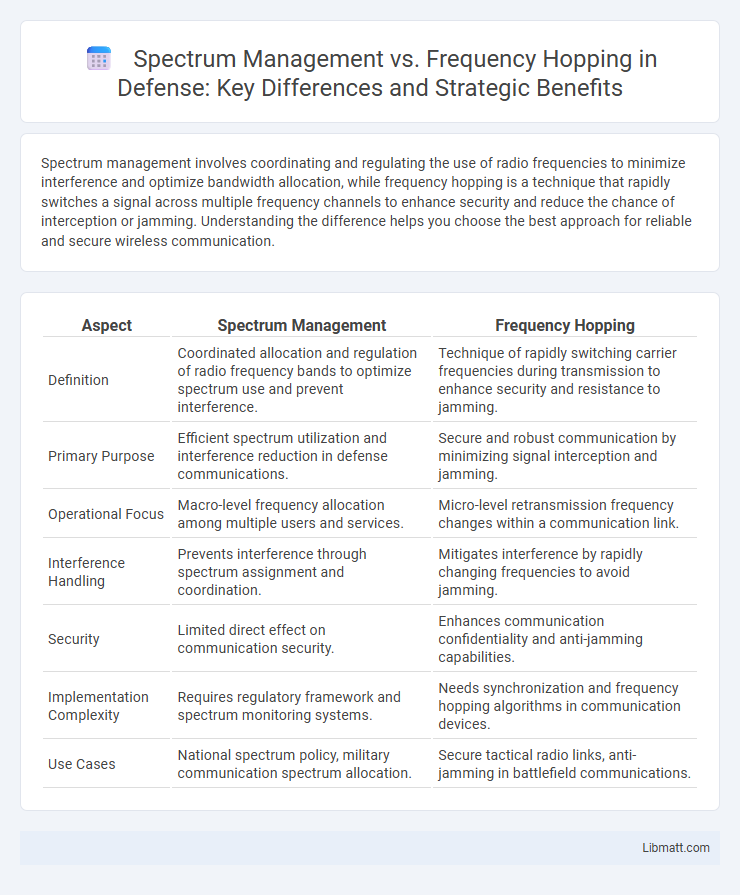Spectrum management involves coordinating and regulating the use of radio frequencies to minimize interference and optimize bandwidth allocation, while frequency hopping is a technique that rapidly switches a signal across multiple frequency channels to enhance security and reduce the chance of interception or jamming. Understanding the difference helps you choose the best approach for reliable and secure wireless communication.
Table of Comparison
| Aspect | Spectrum Management | Frequency Hopping |
|---|---|---|
| Definition | Coordinated allocation and regulation of radio frequency bands to optimize spectrum use and prevent interference. | Technique of rapidly switching carrier frequencies during transmission to enhance security and resistance to jamming. |
| Primary Purpose | Efficient spectrum utilization and interference reduction in defense communications. | Secure and robust communication by minimizing signal interception and jamming. |
| Operational Focus | Macro-level frequency allocation among multiple users and services. | Micro-level retransmission frequency changes within a communication link. |
| Interference Handling | Prevents interference through spectrum assignment and coordination. | Mitigates interference by rapidly changing frequencies to avoid jamming. |
| Security | Limited direct effect on communication security. | Enhances communication confidentiality and anti-jamming capabilities. |
| Implementation Complexity | Requires regulatory framework and spectrum monitoring systems. | Needs synchronization and frequency hopping algorithms in communication devices. |
| Use Cases | National spectrum policy, military communication spectrum allocation. | Secure tactical radio links, anti-jamming in battlefield communications. |
Introduction to Spectrum Management and Frequency Hopping
Spectrum management involves the strategic regulation and allocation of radio frequency bands to optimize wireless communication and minimize interference. Frequency hopping is a specific technique within spectrum management where a signal rapidly switches among multiple frequencies, enhancing security and resistance to interference. Your wireless network's efficiency and reliability can significantly improve by understanding and applying these spectrum management methods.
Defining Spectrum Management: Principles and Goals
Spectrum management involves the strategic planning, allocation, and regulation of electromagnetic frequencies to optimize efficient use and minimize interference across diverse communication systems. Its core principles emphasize equitable access, interference mitigation, and maximizing spectral efficiency to support a broad range of services such as cellular networks, broadcasting, and satellite communications. Your understanding of spectrum management is crucial for navigating challenges in dynamic frequency environments and enhancing overall wireless communication performance.
Understanding Frequency Hopping: Basics and Benefits
Frequency hopping is a communication technique where the transmitter rapidly switches frequencies within a designated spectrum to minimize interference and enhance security. This method contrasts with traditional spectrum management, which allocates fixed frequencies to users to avoid overlap and congestion. By using frequency hopping, Your wireless system can achieve improved resistance to jamming and eavesdropping while optimizing spectrum utilization.
Key Differences Between Spectrum Management and Frequency Hopping
Spectrum management involves the coordinated allocation and regulation of radio frequencies to optimize their use and minimize interference across communication systems. Frequency hopping is a specific technique within spectrum management that rapidly switches a signal among various frequency channels to enhance security and reduce interference. Understanding these distinctions helps you leverage spectrum management for overall frequency allocation, while frequency hopping addresses dynamic signal transmission challenges.
Advantages of Spectrum Management in Wireless Communications
Spectrum management optimizes the allocation and utilization of radio frequencies, enabling efficient coexistence of multiple wireless services while reducing interference and maximizing bandwidth availability. It provides regulatory frameworks that ensure fair access and compliance with international standards, leading to improved network reliability and performance. Effective spectrum management supports scalable wireless communication infrastructure essential for growing demand in IoT, 5G, and other advanced technologies.
Benefits of Frequency Hopping for Signal Security
Frequency hopping enhances signal security by rapidly switching transmission frequencies, making it difficult for unauthorized parties to intercept or jam communications. This technique reduces the risk of eavesdropping and interference, ensuring more reliable and private wireless connections. Your data remains protected through constant frequency variation, providing robust defense against signal interception.
Challenges in Implementing Spectrum Management
Implementing spectrum management faces challenges such as coordinating dynamic frequency allocation to avoid interference and ensuring compliance with regulatory policies across multiple users and devices. Spectrum scarcity and the need for real-time allocation further complicate the management process, requiring advanced algorithms and infrastructure investments. Your communication systems may suffer from degraded performance if these challenges are not effectively addressed, highlighting the importance of robust spectrum management solutions over simpler methods like frequency hopping.
Frequency Hopping: Limitations and Technical Constraints
Frequency hopping faces limitations such as increased complexity in synchronization between transmitter and receiver, which may lead to latency issues in real-time communication. The technical constraints include limited bandwidth efficiency and susceptibility to interference if hopping patterns are predictable or compromised. Your system's performance can be impacted by regulatory restrictions on hopping sequences and the maximum number of frequency channels available.
Integrating Spectrum Management and Frequency Hopping for Optimal Performance
Integrating spectrum management and frequency hopping enhances wireless communication by dynamically allocating frequencies while rapidly switching channels to minimize interference and maximize bandwidth efficiency. Advanced spectrum management systems monitor real-time spectrum usage, enabling your network to select optimal frequency ranges that frequency hopping algorithms can then use to avoid congestion and reduce signal jamming. This combined approach improves overall network reliability, throughput, and security in densely populated or contested electromagnetic environments.
Future Trends in Wireless Spectrum Optimization
Future trends in wireless spectrum optimization emphasize dynamic spectrum management techniques that enhance spectrum efficiency and reduce interference. Frequency hopping remains a critical method, enabling resilient communication by rapidly switching frequencies within assigned bands, which supports secure and robust wireless connections. Your network's performance can significantly benefit from integrating adaptive spectrum management tools with frequency hopping to accommodate growing demand and emerging 5G and beyond technologies.
spectrum management vs frequency hopping Infographic

 libmatt.com
libmatt.com